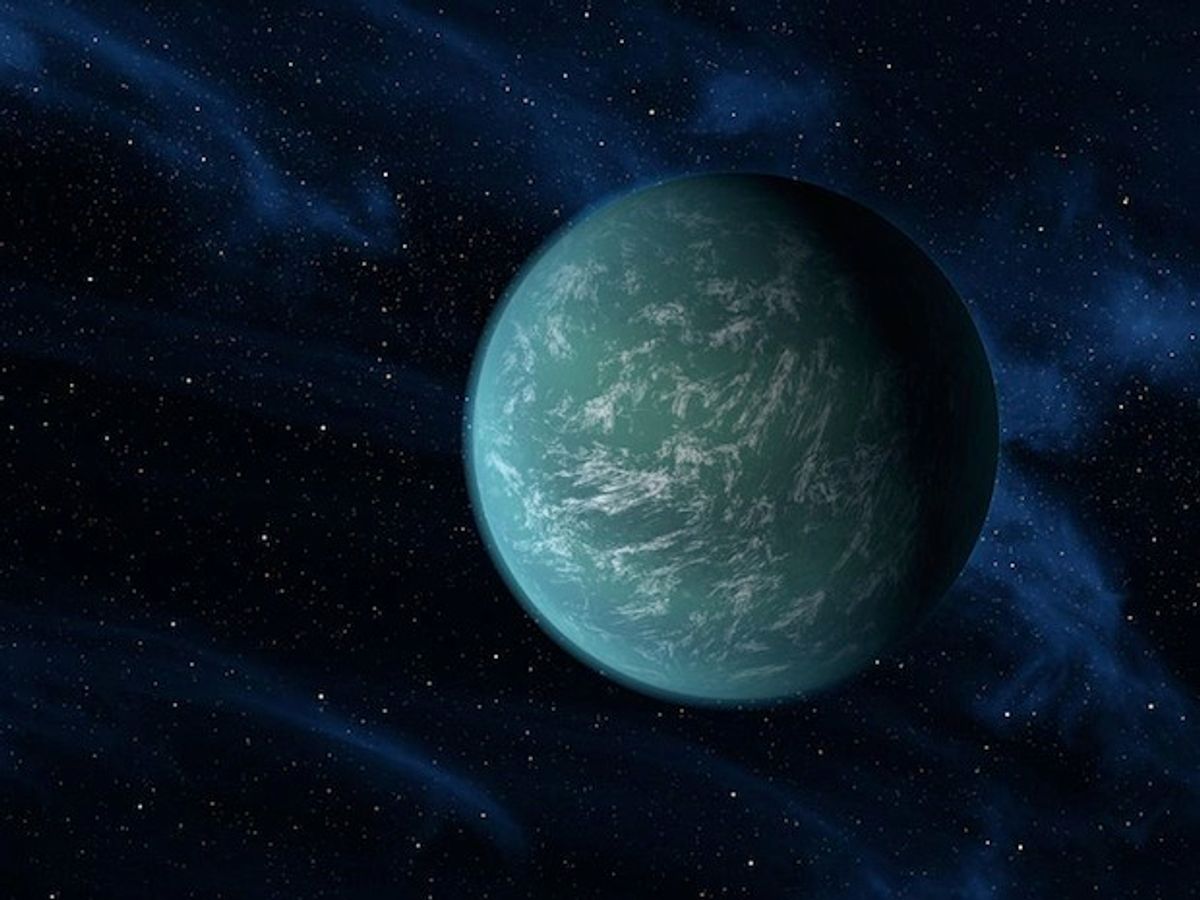There are several hundred billion stars in our Milky Way galaxy, and probably even more planets. And among those planets, a world named Kepler 62f may be really, really special. It just might have complex life, and the whole cockeyed caravan that goes with it: buildings, music, poetry, love, conflict, cuisine, games, engineering, science, taxes, and partisan politics. It may be decades or longer before we know for sure, but so far, astrophysicists can say that Kepler is a smallish rocky world like ours, and it is "right smack in the middle of the habitable zone," in the words of Natalie Batalha, the Kepler Mission Scientist at NASA's Ames Research Center.
Discovered by researchers operating the Kepler Space Telescope, the planet is 1200 light years away. Without knowing whether the planet has water or any of the other factors necessary for life as we know it, Batalha and her colleagues don't now claim to have discovered a habitable planet. Nevertheless, finding Kepler 62f has reenergized planetary scientists. “This is a dream, finding evidence of life beyond Earth,” Batalha declared. “But it's not a pipe dream. It might not happen in our lifetime, but it could happen in the lives of our children or grandchildren, and that's an astounding thing.” NASA has a “roadmap” of three planned and proposed space telescopes out to the year 2022. These will bring greater technological resources to bear, for example enabling scientists to detect the composition of the atmosphere of planets in distant solar systems.
Batalha spoke at the South By Southwest conference as part of a panel session Sunday titled “First Signs: Finding Life On Other Planets.” She disclosed that the Kepler telescope, which was set into orbit in March 2009, has found more than 3800 planets orbiting fewer than 3000 stars. It has been studying a triangle-shaped patch of the sky between the constellations Cygnus and Lyra, within which it can see about 150 000 stars.
Kepler's mission is to detect potentially habitable planets, so all of the 3800 planets it has detected are at least 85 percent smaller than Neptune. Planets much larger than Earth are considered unsuitable, because they would lack rocky surfaces and be shrouded in hydrogen and helium. Planets much smaller than Earth are also ruled out, because they would lack atmospheres.
Of the 3800 planets found, 25 to 30 are “potentially habitable worlds,” Batalha said. Of those, 62f seems the most promising, being just 40 percent larger than Earth. The closest of those potentially habitable planets is just 15 light years from Earth. It's a neighbor in galactic terms: if you shrank the galaxy to the size of the continental United States, 15 light years would be like the one-kilometer stroll across Golden Gate Park.
“Kepler has set the stage,” said Amber Straughn, another panelist, and an astrophysicist at NASA's Goddard Space Flight Center. “We now know not only that other planets are out there, but that they are common.”
NASA plans to launch two more exoplanet hunters in the next several years. The second of those, the James Webb Space Telescope, is expected to usher in a new era in exoplanetary studies. “We're going to move from detecting planets to characterizing planets,” Straughn explained. Kepler uses sophisticated detectors to sense the tiny dropoff in light as a small planet moves across the disc of a faraway star. By measuring that dropoff and its duration, scientists can estimate the planet's size and orbital speed. But they can't tell anything about the planet's atmosphere and composition.
The James Webb telescope, on the other hand, will be equipped with spectroscopic instruments that will make measurements of the atmospheres of the planets. The instruments will characterize the light of the star, and compare it with the light streaming through the atmosphere of the planet. Those comparisons will reveal what wavelengths were absorbed in the planet's atmosphere, thereby giving the researchers a good idea of the compounds in it. The difficulty is the thinness of the atmosphere—it can be thought of as a film clinging to the far-off world. “I think that we are at a unique point in history, to build the technologies to move forward,” Straughn said. “Building these awesome telescopes that will let us find that blue marble out there. And the James Webb Space Telescope is our next stop on that journey.”
The telescope project is a partnership among NASA and the European and Canadian Space Agencies. It is scheduled for launch in 2018, will have a 6.5-meter-diameter main mirror. It is to be put into an orbit around the second Lagrangian Point. This position, known as L2, is about 1.5 million kilometers “behind” the Earth, as seen from the Sun. In this position, the craft would orbit the Sun at about the same rate as the Earth. That means that the spacecraft will be able to use shielding to block the light from the Sun, Earth, and Moon, which will all be near each other continuously from the craft's vantage point. Such shielding is crucial because the telescope's hypersensitive instruments will need to be cooled to prevent spurious noise from overwhelming weak signals from distant worlds.
Said panel moderator Alberto Conti, of Northrop Grumman: “When I was in grad school, when we talked about exoplanets...we didn't know if they existed. Now, we know they're out there. You realize it's an incredibly beautiful universe out there.”
Glenn Zorpette is editorial director for content development at IEEE Spectrum. A Fellow of the IEEE, he holds a bachelor's degree in electrical engineering from Brown University.




